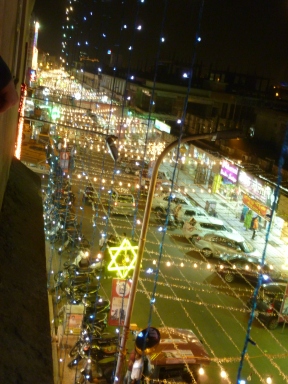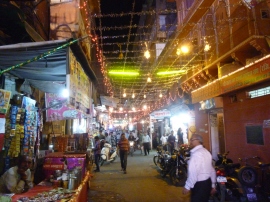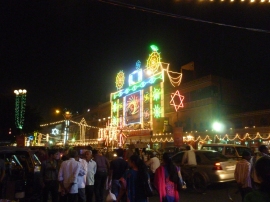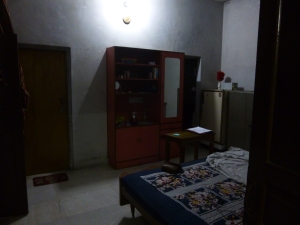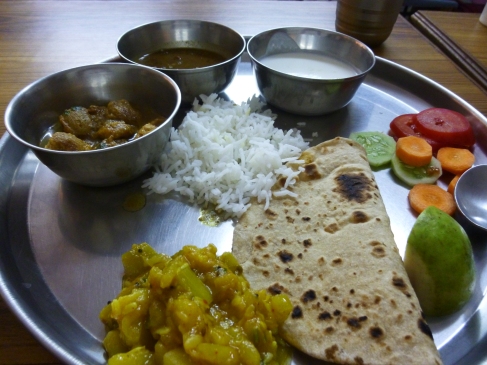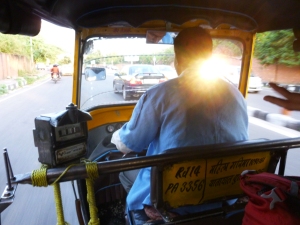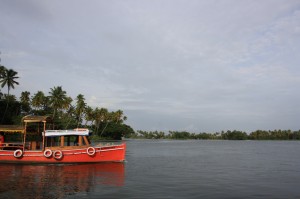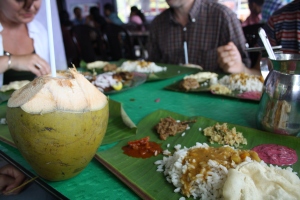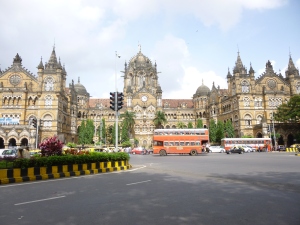
Himalayan foothills
A week is never really enough time to enjoy vast swathes of India at a leisurely pace, but if you are prepared to endure arduously long bus journeys and to go without a good night’s sleep, there are still experiences to be had. In my mere week long half term break, I managed to cram in stops in the northern states of Uttarakhand and Punjab. And I think it’s fair to say it was eventful.
I’m lucky enough to have travelled with fellow students who have relatives living in these states, which entitled me to a week of free accommodation and overwhelming hospitality. (Excluding the slightly less hospitable nights spent in cars and buses). Whilst my four companions and I patiently waited at Jaipur Junction Station for the Ranikhet express to arrive and take us to Kathgodam, the end of the line in Uttarakhand, we discovered that three of our tickets had not managed to make it off the waiting list. I love the Indian railway. Mostly. However, if you are not the kind of person who plans your journeys months in advance, actually making it onto the train can sometimes prove problematic. We had only been foresightful by a measly three weeks – not enough time to contend with the rest of Indian’s burgeoning population. However, three of us not being technically allowed to board the train didn’t seem to be enough for us to rethink our carefully scheduled plans, so we boarded anyway, armed with distant friends-in-high-places’ telephone numbers and a conviction that everything would be alright.
We squashed together in one berth and got to know the surrounding families, who soon came to learn about our situation. A generous Gujarati family insisted on sharing their food with us and my hand was beautifully hennaed by a woman I never knew the name of. They even went so far as to offer sharing their space with us, if no other bunks could be found on the train. Shamefully supporting India’s internal corruption, a bribe was paid to pacify the ticket inspector and to support the vague hope that we would somehow be permitted to remain on the train until its final stop. Alas, in spite of this futile gesture and in spite of the generous offers we’d received, we were made to leave the train at Old Delhi Station. The journey thus far had not quite gone as planned and Jaipur to Delhi had taken twice as much time as it realistically should have done. However, I had been once again provided with the opportunity to indulge in one of my most beloved past-times: leaning out of the speeding train to watch the world whiz past. So for now I could remain content.
I’m not a particular fan of Delhi at the best of times, but Old Delhi Station in the middle of the night is not a destination I would recommend to anyone. Unless, of course, you want rabies or dengue fever or an argument with incoherent drunkards. We waited maybe an hour and a half amongst the filth and the chaos for a car to arrive and take us the rest of the way. While a private car may sound like luxury in comparison to India’s generally overcrowded public transport system, never before have I experienced a road that is made more of pot holes than of actual road. We managed to snatch perhaps a few hours of sleep in amongst our comical lurching and bouncing. I’ve no idea how. But by morning, as we started to wind our way up into the foothills of the Himalayas, all the drama of the previous evening seemed long ago. Everything was worth it now. Worth it twice over. I don’t think I’ll ever forget that first sight of those snow capped peaks suddenly coming into view, stretched out on horizon as if a child had painted a jagged white line on the sky. At the end of a long 20 hour journey, we had finally made it to paradise. I could sit here all day and make pretentious statements about how beautiful everything was, but really you should just go and stay in Mukteshwar and see it for yourself. A view of India’s highest Himalayan peak, sunsets to rival all others, bottomless valleys, bonfires. What more could you want?
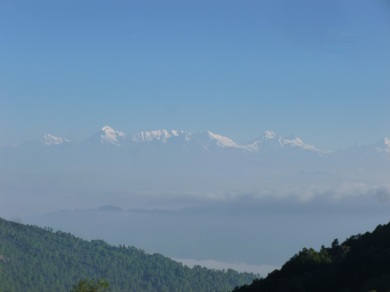
After two days of pleasant walking in the hills, admiring the views and scenic boat trips, we had to head westward. With our group disbanding, three of us took an overnight bus from Nainital to Uttarakhand’s capital of Dehradun. However we merely passed through the city in an Autorickshaw, briefly admiring how clean it all seemed, before taking another bus to Mussoorie. I noted that goats are also permitted to board buses in Dehradun. I remain unconvinced as to whether the route to our day trip location was more stunning or terrifying. As the speeding bus lurched round hair pin bends on sheer cliff edges, I could only close my eyes and pretend that I wasn’t really 6,000 feet about sea level and that the mountains were made of bubble wrap. Clearly, however, I am still alive and made it safely to Mussoorie. The town itself was shrouded in cloud and did not offer the magnificent mountain views we had previously experienced, but nevertheless we indulged in Tibetan momos and visited the beautiful Kempty Falls, the first fresh water I’ve encountered in India clean enough for paddling! Back in Dehradun for the night I became the recipient of yet more Indian hospitality. Mukteshwar had already offered us beautiful meals, accommodation and conversation, but again I was being presented with not only the cooking of someone else’s distant relatives, but gifts and an invitation to return, a scenario that would continue to repeat itself in Punjab.

A goat on board a bus . . .

Kempty Falls
We were late leaving on our early morning start to catch the bus to Phagwara, Punjab. As we approached the bus station we watched with dismay as our bus drove away in the opposite direction, without us on board. But don’t let insignificant formalities such as bus stops get you down whilst in India. With some yelling from the car window and the help of an anonymous motorcyclist, we managed to pull the bus over to the side of the busy main road and clamber on board, awkwardly dragging our luggage the length of the aisle to the back of the bus, all eyes silently fixed on the disruptive latecomers. Aboard a cheap, non A/C bus, the route to Phagwara was long and uncomfortable, but we passed through the states of Himachal Pradesh and Haryana from Uttarakhand on our way to Punjab, watching the landscape change from dramatic mountain backdrops to endless fields. Punjab is not exactly what I expected it to be. I had in mind the dust similar to that here in Rajasthan, but it is green and fertile. Sometimes referred to as ‘India’s bread basket’, it is the country’s largest producer of wheat and, in fact, one of the most fertile regions on earth. Finally leaving our seats, we were taken straight from the bus to a nearby Punjabi village where we were set to meet yet more relatives. In an extensive joint family set up we were introduced to aunts and cousins and in another overwhelming display of hospitality showered with chai and gullab jamuns and deep fried treats. My friend and I were apparently the first white girls to have visited the village since Indian independence. While we get ‘noticed’ at the best of times, clearly some people seemed surprised to see us there. . .
The following day we headed onward to Amritsar, home of the famous Golden Temple. Simply put, it’s beautiful. The temple itself is impressively situated in the centre of a large pool, it’s reflection shimmering on the water’s surface. Just sitting by the water’s edge to admire the design is a rather peaceful activity. However, actually getting inside to see the golden interior was one of life’s more stressful occasions. A special day in the Sikh calender meant that more than usual people had flocked to this holy site. It took perhaps two hours to cross the actual threshold, and the whole while I desperately hoped that someone would give the crowd a lesson in British queuing. Never ever complain about having to wait in a queue again. A nice, polite, formal queue, in which everyone respects your personal space and you have full use of your arms. This seemed more like a mad crowd of desperate souls trying to escape from a burning building, rather than enter a holy temple. It’s a good job inside was beautiful too, otherwise I would have regretted not jumping over the fence and into the water to escape from the riot outside it.
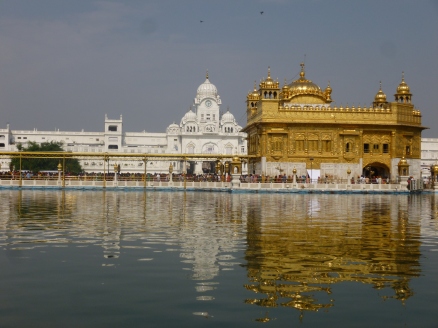
The Golden Temple
From the Golden Temple we rushed yet further westward to make the evening’s Indian-Pakistani Wagah Border closing ceremony. Both sides pull this insane stunt every single day around sunset. If you ever happen to be in Punjab, do not miss the opportunity to see it. Cars are not permitted within 500 meters of the border and so as the spectacle was beginning to commence, swarms of other latecomers were rushing alongside us towards their country’s boundary, bypassing the men selling drinks, snacks and Indian flags and hoping to get a seat. The excitement was infectious and we were running. As we got closer we could hear Jai Ho blaring from loudspeakers and the sound of the cheering crowd drifted high into the air. Courtesy of our UK and American passports, we managed to largely avoid the crowds, heading to the back entrance to be seated in our own separate foreigners section. On both sides of the countries’ dividing gate, the seating area looks like a sports stadium. And it was packed. It felt like arriving at some sort of concert rather than a border. Can you imagine if people made such a fuss driving from, say, France to Italy? I don’t think you’d even notice that you were in a different country, if you missed the welcome sign. We watched in amusement as the Indian guards marched and strutted like peacocks in a face off with the equally as flamboyant Pakistani representatives and joined in with the calls of “HINDUSTAN, ZINDABAD!” [long live India]. There was some rather impressive kicking skills on behalf of the guards and I would recommend you check out the YouTube video for a taste of the experience. Seeing is believing, after all.
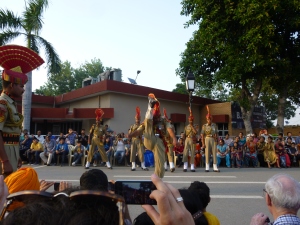
Impressive flexibility of an Indian guard
However, while this whole spectacle appears a thoroughly entertaining affair when taken at face value and I would happily recommend viewing, there is something more disconcerting which lies beneath the surface of this bizarre performance. The Wagah border gate is the only accessible crossing point on the 1,800 mile long dividing line between India and Pakistan. That’s 1,800 miles of barbed wire and gunmen. The partition of India and Pakistan left behind a bloody legacy in the aftermath of India’s rushed independence, with estimates of up to a million deaths in the violent mass transition of Hindus, Muslims and Sikhs fleeing from one newly formed country to the other. The border, heralded today as one of the world’s most dangerous, was originally an imaginary line drawn onto a map by the incompetent British lawyer Cyril Radcliff. Upon its construction, this long and threatening wall sliced through fields and villages. People lost their homes and livelihoods and were torn from their once peaceful communities. And long since the tragedy of partition, India and Pakistan continue to be known for their difficult relationship.
Many put the rivalry down to religion; India and Pakistan cannot get along because India is a Hindu country and Pakistan a Muslim one. Yet India’s Muslim population stands at approximately 176 million people, only just falling short of the entire population of Pakistan. If 176 million Muslims can live peacefully within India, I fail to understand how religion can really still be a substantial explanation for the divide – both physical and psychological – of these two countries. Why and how can there be so much separateness and even hatred between these people that once lived side by side, that there requires every single evening a grand showdown to assert the superiority of either side, I fail to fully comprehend. Indians and Pakistanis once had nothing with which to divide themselves; their nationalities were given to them in 1947 in the wake of independence from Britain and even today on either side of the Punjabi border, people speak the same language, wear the same clothes, eat the same food and share other such similar practices. There is no obvious visible difference. While patriotism can perhaps be a positive concept in small, healthy doses, the extent to which it can be felt at the Wagah border I find a little unsettling. As I see it, patriotism stems from pride in your place of birth; an uncontrollable chance phenomena which should really be inconsequential, and yet it often fuels the sad and mindless division between people around the world who could otherwise be neighbours.
I seem to have gone on rather a tangent from the original details of my holiday, but I am approaching the end of the trip now, regardless. A final day away from Jaipur was spent exploring the main clothes and fabric bazaar of Phagwara. While India is full of beautiful colours, patterns and sparkly trinkets ready and waiting to entice you into shops, shopping itself is still a skill I’m somewhat lacking in. I’m not exactly an expert back home either, but the traditional Indian format of choosing what to purchase is even more daunting for the difficult and indecisive customer such as myself. Generally, clothes are not made available for rummaging through at a leisurely pace, but are folded up, stacked away on shelves behind a counter and presented to you item by item by the shopkeeper. Here generally ensues the guilty feeling as the piles of clothes start to form untidy mountains along the counter and I shake my head at each new garment revealed to me. Yet the shopkeeper persists with frustration to make a mess of his previously immaculate shop as I struggle with the inability to precisely explain what it is I’m looking for as I invariably have little idea. On the few occasions that I overcome the guilt and decide to embrace the experience, bargaining is a must. And if you are a foreigner, you need to bargain hard. The understandable, yet nevertheless frustrating consequence that comes with being of an obviously different nationality in this country, is that you are eternally presumed to be the ignorant and wealthy tourist, the outsider, the easy target to be tricked out of large sums of money. While normally I can quickly win people over by conversing in their mother tongue, it is having to constantly replay the same motions over again which can get boring. Look, I live just round the corner, I know you’re trying to rip me off, and no I don’t need a taxi, I know where I am.
To get back to Jaipur, we had to take an early morning train from Phagwara to Delhi and then endure another long bus journey the rest of the way. On finally tracking down a bus heading in the right direction we discovered that the battered old thing had little luggage storage space save for the rack on it’s roof, accessible only by vertical ladder. In our company were two large suitcases which we were not going to be allowed to bring on board the vehicle. The only option appeared to be the ladder. But how to you climb a ladder with a heavy suitcase in tow without any assistance from the bus staff? It turned out the answer was simple. Send the white girls up onto the roof and immediately a crowd of men will appear from nowhere insisting you get down immediately and they will do it instead. I wasn’t quite sure whether the gesture translated more as “girls, please, you are not capable of doing a man’s job” or “stop, you will probably fall and die and we do not want the hassle of a foreigner’s death on our hands,” but I imagine somewhere in there was the assumption that we would injure ourselves. Once on the move, I overcame my disgruntled feelings at the assumption of our female inability, pleased to have been finally sold a ticket and to be heading back home to resume my life in Rajasthan, where all is pleasant apart from the lingering cravings for real cheese and baked beans.
http://www.youtube.com/watch?v=UxLSZoFK8EM – ‘Jai Ho’ (theme tune to our dramatic entry at Wagah Border)
http://www.youtube.com/watch?v=LZ0ue-XGl9c – The Border Closing Ceremony.
